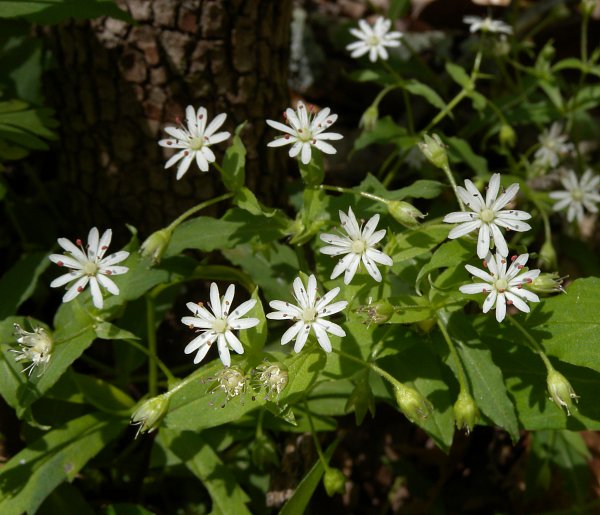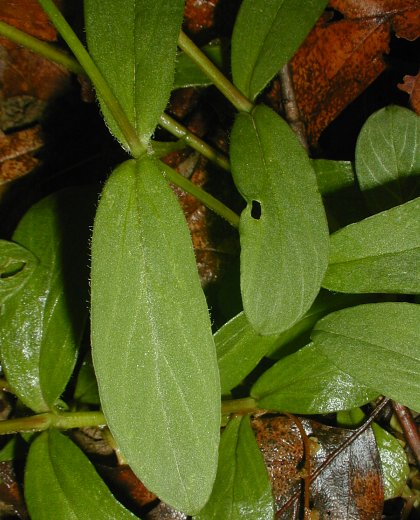Description: This perennial wildflower is about 6-12" tall and unbranched, or sparingly so. Both fertile and infertile shoots are produced; the latter develop later in the year and don't produce flowers. The central stem is light green to pale purplish green and glabrous to moderately pubescent. The opposite leaves are up to 3" long and 1¼" across; they are ovate, lanceolate, oblanceolate, elliptic, or broadly oblong. The upper surface of these leaves is medium to dark green and finely pubescent (sometimes sparsely); their margins are smooth (entire) and ciliate. The leaf bases are sessile or nearly sessile, while their tips are either acute or blunt; lower leaves are more likely to have short petioles and blunt tips than upper leaves.

The central stem of each fertile shoot produces a terminal cyme of flowers; occasional individual flowers may develop from the axils of the upper leaves. Each flower is about ½" across, consisting of 5 green sepals, 5 white petals (looking like 10 petals, because each petal is deeply bifurcated), a white ovary with 3 styles at its apex, and 10 stamens with reddish brown anthers. The petals are about the same length or a little longer than the sepals. Each sepal is lanceolate to ovate and pubescent. The pedicel of each flower is up to 1" long and pubescent. The blooming period occurs from mid- to late spring and lasts about a month. Each flower is replaced by an ovoid capsule that is open at its apex; it has 6 curved teeth around its upper rim. Each capsule contains many small seeds that are globoid, somewhat flattened, and minutely warty. Each seed is often slightly notched on one side. The root system consists of a taproot with slender fibrous roots. Small colonies of plants are occasionally formed.

Cultivation:
The
preference is dappled sunlight to light shade during the spring,
followed by light to medium shade. The soil should be well-drained but
consistently moist, with an abundance of organic matter and a layer of
decaying leaves. It should also be somewhat acidic. Shallow rocky
ground and slopes help to reduce competition from taller plants.
Range & Habitat:
The native Star Chickweed is a rare plant in Illinois, where it is
state-listed as 'endangered.' It has been found in Pope County of
southern Illinois, and a few counties in NE Illinois (see Distribution
Map). Illinois lies at the NW corner of the range for this
species. It is more common in the southern half of Indiana and other
states. Habitats include edges of rocky meadows, rocky wooded slopes,
wooded bluffs, and the upper slopes of sandstone ravines. Outside of
Illinois, another typical habitat is rich mesic woodlands. This
conservative species is found in high quality woodlands, especially
where sandstone is close to the ground surface.

Faunal
Associations:
The flowers of Star Chickweed attract cuckoo bees (Nomada spp.), mason
bees (Osmia spp.),
Halictid bees (Augochlorella
spp., Lasioglossum
spp.), Andrenid bees (Andrena
spp.), the Giant Bee Fly (Bombylius major),
Syrphid flies, and other miscellaneous flies. Butterflies and skippers
are rare visitors of the flowers. These insects are attracted primarily
to the nectar of the flowers, although some of the bees collect pollen
for their larvae and some of the flies feed on pollen as adults.
Insects that feed on Stellaria
spp., including possibly this chickweed, are the aphid
Abstrusomyzus phloxae,
the Pale Tortoise Beetle (Cassida
flaveola), and caterpillars of a moth, Lobocleta ossularia
(Drab Brown Wave). Information about this chickweed's ecological
relationships with vertebrate animals is currently unavailable.
Photographic Location:
The edge of a rocky meadow and the wooded upper slope of a sandstone
ravine at Shades State Park in west-central Indiana.

Comments: Of all the chickweeds (whether native or introduced), Star Chickweed is arguably the most attractive. It's a pity that this species isn't more common in Illinois. The only other chickweed in Illinois that resembles it is Myosoton aquaticum (Water Chickweed), which is native to Eurasia. This latter species can become larger in size than Star Chickweed, and its leaves are usually more broad toward their bases. Even more importantly, the flowers of Water Chickweed have 5 styles and its seed capsules have 5 teeth. In contrast, Star Chickweed has flowers with 3 styles and seed capsules with 6 teeth. Water Chickweed, as its common name suggests, also prefers damp water-logged habitats, such as roadside ditches and low areas along rivers. Other common names of Stellaria pubera are Giant Chickweed and Great Chickweed; these names sometimes refer to Myosoton aquaticum as well.